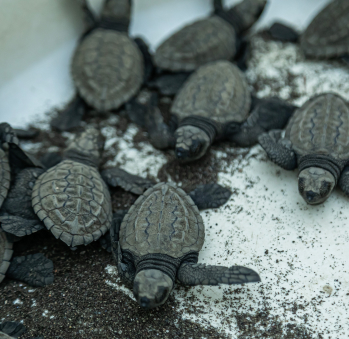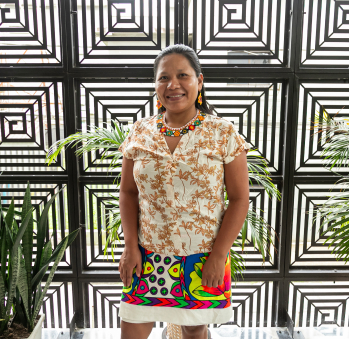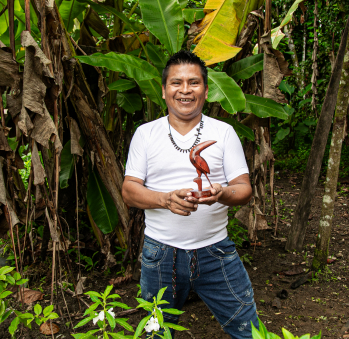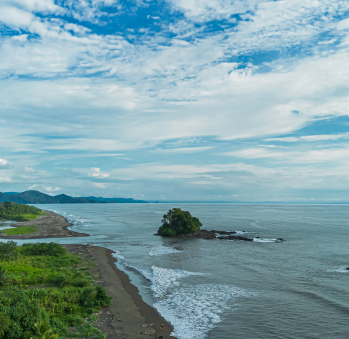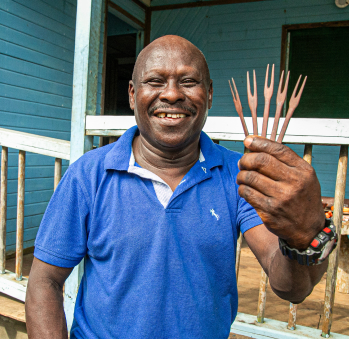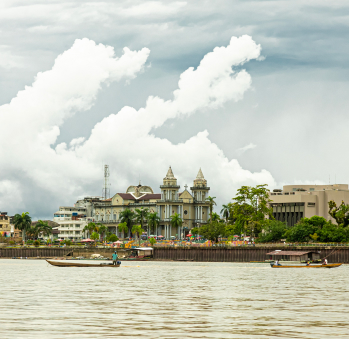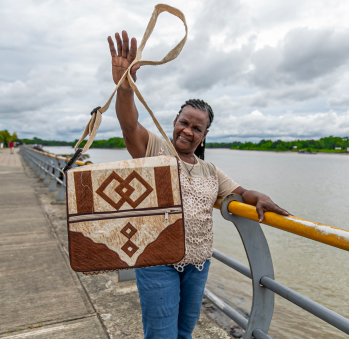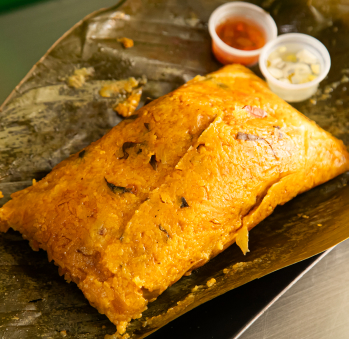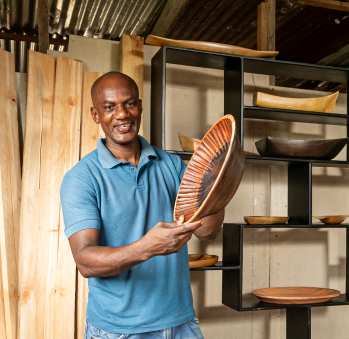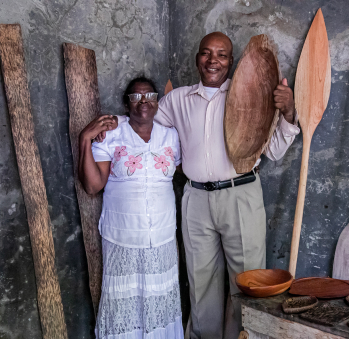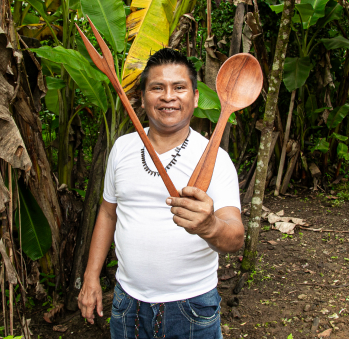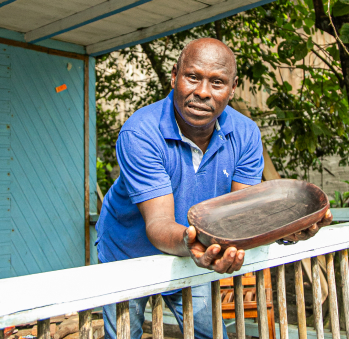Choco Route
Going to Chocó is a decision. It’s a journey to the Colombian Pacific that requires a full willingness to discover a world you want to deeply explore and experience. It’s an immersion that allows understanding how life thrives in such a profoundly beautiful place, where people usually feel forgotten by their country. However, this doesn’t make its inhabitants downtrodden; quite the opposite, each one of them exudes a strength that emanates from within, a force ingrained in their skin, knowing that there’s no time for lamentation. Instead, they resolve everything with the power of hard work and faith, both seasoned by the spirit of celebration and the taste of their recipes. They take pride in having a river in their blood: the immense Atrato.
These are the qualities we want to introduce to you on this artisanal route through Quibdó and Bahía Solano. We invite you to navigate the greenish-blue waters of Ensenada de Utría, where whales are born, adjacent to Nuquí. Understanding this territory means acknowledging that Black communities and Tikuna and Embera indigenous peoples have shared this humid land since ancient times. It also means honoring the devotion to a patron saint, San Francisco de Asís, affectionately known as San Pacho, who is treated as a guardian angel, protecting and allowing everyone to pray, sing, and dance joys and sorrows from September 20th to October 4th each year. Quibdó locals happily describe living in close quarters, as half a block from their homes is filled with family. They’ve become famous for the tremendous spiritual celebration held there.
In this adventure, we’ll introduce you to master carvers of oquendo, choibá, or guamo woods, and bead jewelers. We’ll present the skills of master weavers who celebrate the beauty of fibers such as damagua and iraca palm. To complement this journey of crafts, we propose completing the experience by visiting the Tutunendo natural park and ecotourism trail, next to Quibdó, a biodiverse, sustainable, and certified destination (meeting 118 requirements, 60 of which are environmental), a setting teeming with rivers, waterfalls, and lush nature where birds can be spotted.
Moreover, we invite you to join the inhabitants of Bahía Solano in the wonderful task of releasing turtles on their beaches. And let’s not forget that in Chocó, you can also taste artisanal alcoholic beverages like viche or savor a delicious longaniza rice… as you’ll see, the layers you’ll encounter in this destination are infinite, so visit this department!
Embark on a journey full of history
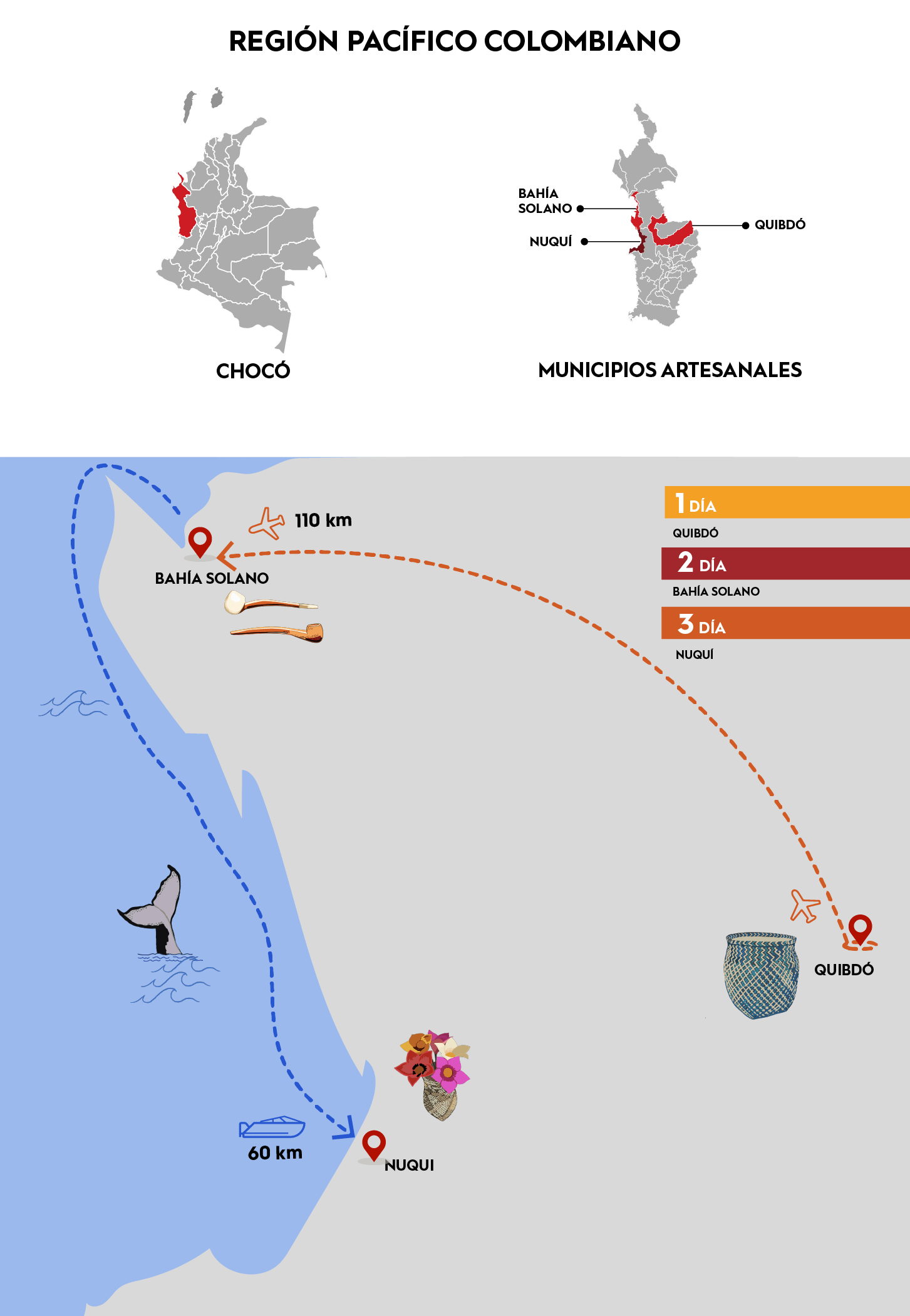
Artisans along the way
Artisans along the way
We recommended this tour
Schedule the visit in advance with the artisans.
Carry cash
Preferably go with a tour operator
3 days
Plane
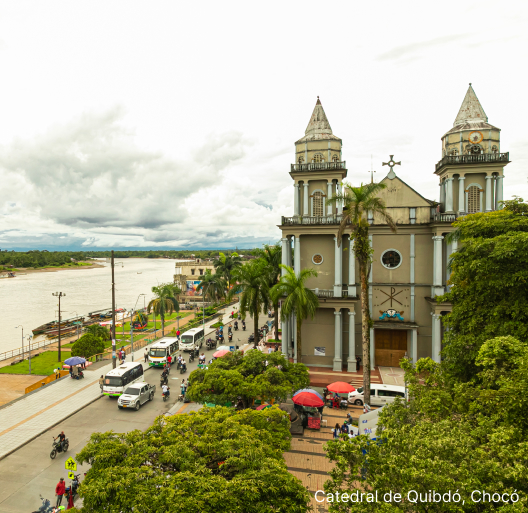
QUIBDÓ
In Chocó’s capital, there are endless plans to make. Spend one day visiting master carvers Adriano Corrales and José Félix Murillo, Embera jeweler Rosa Helena Chamorro, or weavers Géminis Audivet and María Delfina Mosquera. You can plan your visit by taking an architectural route through its historic center, where the obligatory stop is the San Francisco de Asís Cathedral, while also contemplating the vastness of the Atrato River from its boardwalk. The San Pacho Festivities (from September 20th to October 4th) have been recognized as intangible cultural heritage since 2012 for commemorating the resistance and diaspora of the African people. Likewise, don’t miss the gastronomic route—visit the market square and typical restaurants to taste cheese soup, longaniza rice or atollado, and fish such as cod or tapao. Add the ancestral beverage route, where you can learn about viche and other drinks made from medicinal plants at the Balsámica Museum. Last but not least, the traditional music route at Cumbancha, where you can experience the sound of a chirimía on weekends. However, if your plan is more ecotourism and adventure-oriented, we have the perfect plan for you! Visit the Tutunendo Park, Chaparraidó, Rio Ichó—an ideal paradise for nature enthusiasts, both amateurs and experts. Its trails have been featured on Global Bird Day, thanks to its diverse bird population. Don’t miss trying the honey extracted from their beehives.
BAHÍA SOLANO
The best way to reach this destination is by plane from Quibdó, Medellín, Cali, or Bogotá. In this paradise where people wake up to the sound of waves, you can meet Gilberto Jave and Denis Onorio Mecha, both carvers with different learning origins—Gilberto with a fishing background and Denis from an indigenous tradition. Besides, don’t miss the opportunity to join Gilberto’s leatherback turtle release class on El Almejal Beach—an exclusive experience from September to November when they hatch. These sands are the highest nesting site for these animals along the entire Pacific coast of South America. Additionally, here you can see humpback whales leaping across the ocean from July to November. It’s a place where you can also learn to surf and dive, as well as navigate the Tundó River, a landscape filled with mangroves and dozens of sheltering birds. It will be an ideal space for you to learn about this tropical rainforest ecosystem. With an abundance of culinary and hotel offerings, you’ll spend some fabulous days here.
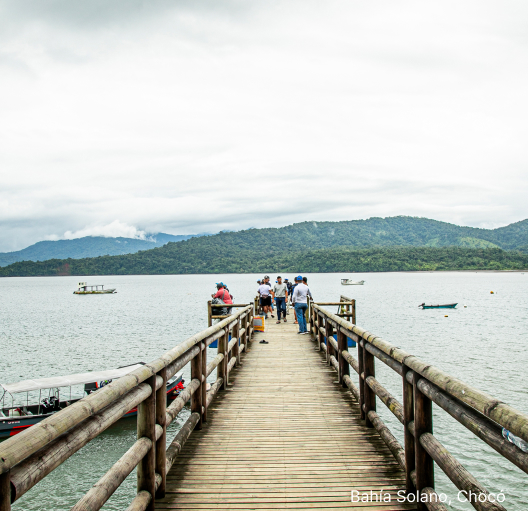

NUQUÍ
You can reach Nuquí from Bahía Solano by traveling along the Pacific coast; there’s a boat that goes from one destination to the other a couple of days a week. You can also reach it directly from Medellín. It’s a place where you can immerse yourself in Afro communities’ traditional food and music—an atmosphere of celebration and flavor. Additionally, it’s the gateway to access Ensenada de Utría, a body of warm blue and green waters where whales are born between July and October. It’s a mangrove landscape where the tide adjusts daily, filling and emptying its beaches. It’s also a place where swimming at night in its calm waters offers the chance to witness the plankton’s bioluminescence. It’s the perfect place to escape everyday life since there’s no signal, and no one can call you. You can kayak and snorkel at Huina, Playa blanca, Guachalito, Morromico, Coquí beaches, or immerse yourself in the Jurubirá hot springs.

Traditional cuisine
and typical bites
Provoke yourself

Don't leave without eating this 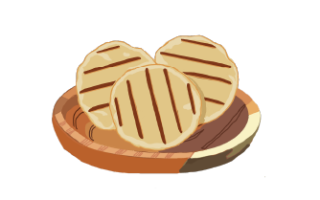
La cocina chocoana es una expresión de la diversidad cultural y natural de la región del Pacífico colombiano. Se caracteriza por el uso de ingredientes naturales que provocan sabores explosivos, haciendo de sus platos el vehículo ideal para recrear los imaginarios colectivos de una región. La cocina de Quibdó se ve influenciada por su historia y geografía, fusionando los sabores y saberes de la cocina española, la indígena y la tradición culinaria de la comunidad afrodescendiente. Algunos de los platos típicos de la cocina chocoana son el capricho de camarón, el mondongo chocoano, la entrada de longaniza, el bacalao, el encocado de pescado, el sancocho de gallina y el arroz con coco, entre otros. ¡Imperdibles las visitas a las plazas de mercado!
Flavors to discover and snack on 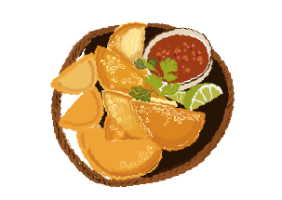
Algunos de los platos más representativos son la sopa de queso, una sopa con queso, pasta y papa que se condimenta con ajo, cebolla y caldo de gallina. Muy parecida al mote del Caribe pero con la deliciosa sazón de la hierbas de azotea, condimentos como el cilantro cimarrón, el oreganón, el poleo o menta, las albahacas verde y negra y el achiote, que se suelen sembrar en altura (de ahí su nombre) dada la humedad de la región. También encontramos el arroz bochinche que es un arroz con longaniza y carne de cerdo, bañado con una salsa de tomate, cebolla, ajo, zanahoria, habichuelas y arveja; muy famoso por el uso de la longaniza ahumada. El arroz de maíz con camarón de río, que se cocina con jugo de maíz molido, queso salado y camarones de río cocinados con cebolla, tomate, poleo, cilantro, albahaca y ajo. De nuevo, el protagonista es el sofrito de hierbas de azotea. Y por último, por supuesto el pescado frito, apelando a un pescado fresco de temporada que se sofríe y se acompaña con arroz de coco, ensalada y patacones.
To sweeten the palate and unmissable drinks 
Los dulces más tradicionales del Chocó son una delicia para el paladar, elaborados con ingredientes naturales y locales, como el coco, el borojó, la yuca, el maíz y la panela. Algunos de los postres más representativos son las cocadas, bolitas fritas de coco rallado con azúcar o panela, que pueden llevar otros sabores como guayaba, piña, fresa, avena, zanahoria o leche. Se comen como bocadillo o postre. El postre de birimbí, que es una colada espesa y fermentada de maíz pilado con panela, canela, clavos de olor y hojas de naranjo. Se sirve frío o caliente, con un poco de leche. El dulce de papaya verde, con coco rallado, y cocinado con panela y clavo de olor. Se deja secar hasta el punto deseado. La mermelada de borojó, dulce y ácida, y que se hace con la pulpa del borojó y azúcar. Se puede untar en pan o galletas, o usar como relleno de tortas o empanadas. Y, la torta de zanahoria, un pastel suave y húmedo que se hace con zanahorias cocidas y molidas, queso blanco rallado, miga de pan, mantequilla, huevos, harina de trigo, leche cremosa y vainilla. Se puede decorar con crema o coco rallado.
El Chocó tiene una gran variedad de bebidas típicas, pero una de las más populares es el arrechón, una bomba energizante que se prepara con leche, leche condensada, crema de leche, brandy o ron, canela, clavos de olor, nuez moscada, vainilla, panela y borojó. Se sirve fría y es todo un mito porque se dice que es afrodisíaca. El jugo de borojó, que es una bebida refrescante y nutritiva que se elabora con este fruto de un árbol endémico de la región del Pacífico. Se mezcla con leche, agua, panela, huevos, vainilla y hielo y produce un sabor dulce y ácido a la vez. Y cómo no mencionar el famoso viche, que es una bebida alcohólica artesanal que se obtiene a partir de la fermentación de la caña de azúcar antes de su maduración. Tiene un alto grado de alcohol y se consume en ocasiones especiales o festivas.
También está el jugo de yuca, una bebida espesa y dulce que se hace con yuca cocida, leche, panela y canela. Se puede tomar caliente o frío y se acompaña con queso o galletas. Y, por último el tradicional chocolate de leche con coco, caliente y cremoso, con leche, chocolate, coco rallado, azúcar y canela. Se toma en el desayuno o en la merienda y se suele acompañar con pan o arepas.
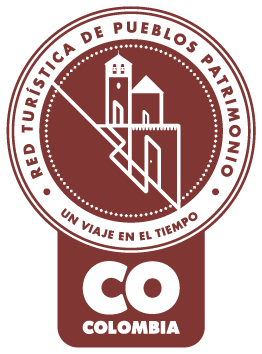
Pueblo Patrimonio
La Red Turística de Pueblos Patrimonio de Colombia es un programa especial del Ministerio de Comercio, Industria y Turismo, ejecutado por FONTUR, que trabaja con 17 municipios de Colombia que poseen declaratoria de Bien de Interés Cultural (BIC) a nivel nacional para su valoración y proyección mediante el turismo, generando así más oportunidades de desarrollo y sostenibilidad en las comunidades.

La Medalla a la Maestría Artesanal es un galardón que Artesanías de Colombia entrega anualmente, con el cual se hace un reconocimiento a aquellos artesanos, empresas y comunidades artesanales que, contando con una trayectoria destacada, sobresalen a nivel nacional por su excelencia en el oficio así como por preservar el quehacer artesanal.

Denominación de Origen
Es un signo distintivo que identifica productos reconocidos o famosos por tener una calidad o características específicas derivadas esencialmente del lugar de origen y la forma tradicional de extracción, elaboración y producción por parte de sus habitantes. La protección conferida sobre una Denominación de Origen implica que ninguna persona puede identificar con la denominación protegida productos iguales o similares a los amparados, cuando no provengan del verdadero lugar y no cumplan con las características o calidades que le han dado la reputación al producto reconocido. Las Denominaciones de Origen para productos artesanales colombianos que han sido protegidas por la Superintendencia de Industria y Comercio en nuestro país son actualmente 12.
No puede copiar contenido de esta página









































